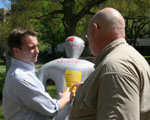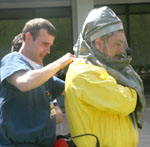|
by Melissa Lacas
Public Relations
Natural disasters, terrorist attacks and other major events often cause
unpredictable consequences. Prepared with the knowledge and skills
needed to handle a high volume disaster, medical students experienced
the effects, albeit staged, from a weapon of mass destruction (WMD)
during a drill held in the Horseshoe March 30.
 Matt
Kappus discusses the respiratory rate and pulse of a mock patient with
Dr. Ralph Shealy during the Internship 101 disaster training session. Matt
Kappus discusses the respiratory rate and pulse of a mock patient with
Dr. Ralph Shealy during the Internship 101 disaster training session.
More than 50 College of Medicine (COM) students worked with inflatable
disaster training mannequins simulating WMD victims as part of a
drill hosted by the COM Internship 101 program and coordinated with the
S.C. Area Health Education Consortium.
“Mass casualties are a fact of life in the Charleston area,” Bob
Mixter, EMS director for Berkeley County said. Mass casualties can
range from tour bus accidents to a chemical leak in a workplace. Within
the past year, about nine incidents have resulted in numerous injuries
in the Lowcountry.
 An
inflatable disaster training mannequin stands against a trashcan while
nearly 100 mannequins lay scattered around the Horseshoe. An
inflatable disaster training mannequin stands against a trashcan while
nearly 100 mannequins lay scattered around the Horseshoe.
First responders and hospitals must also be prepared for mass events
such as bridge failures, plane crashes and port disasters, as well as
terrorist and natural events, such as hurricanes or pandemics.
“In order to follow the utilitarianism rule, which is the
greatest amount of good for the greatest amount of people, we must use
a system to quickly categorize victims,” Mixter said.
 Andrew
Jameson helps James Gambrell put on his protective mask before he
enters the decontamination lab. Boots and suits were also provided. Andrew
Jameson helps James Gambrell put on his protective mask before he
enters the decontamination lab. Boots and suits were also provided.
Students were taught how to test a victim’s respiration, pulse and
mental status in less than 30 seconds in order to classify each patient
objectively, efficiently and rapidly, using the simple triage and rapid
treatment system.
Friday, April 3, 2009
|





